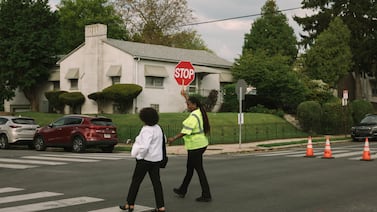There are three pies and four monsters. How much pie will each monster eat?
That was the math question before five soon-to-be fifth graders earlier this week at Summer Connections, Denver Public Schools’ full-day summer program for elementary students.
With dry erase markers and personal white boards, the students sat in a loose semicircle on the floor of a classroom at Joe Shoemaker elementary school, puzzling out the answer. A student named Gael was the first to solve it.
“Gael says three-quarters,” the teacher said. “Why, Gael?”
Smaller class sizes, a mix of academics and fun, and acceleration instead of remediation — meaning incoming fifth graders do fifth grade work instead of reviewing fourth grade skills — are the hallmarks of Summer Connections, which is now in its second year and serving about 1,860 elementary school students.
But it’s hard to understand whether the program, which is funded by federal COVID relief dollars and meant to help students catch up on lost learning, is having the intended effect.
Initial data comparing the spring and fall reading scores of first through third graders who had attended Summer Connections last year showed they did not experience “summer slide,” or the loss of academic skills. That was good news, given that the same data showed that students who did not attend Summer Connections did experience summer slide in reading.
But a more detailed analysis showed no difference in reading scores between the two groups. That analysis, which matched Summer Connections students with non-Summer Connections students who were similar demographically and academically, found the two groups “had statistically identical average fall test scores,” according to a district memo.
A pre-pandemic half-day summer program called Summer Academy had the same outcome.
In an interview, Angelin Thompson, the director of extended academic learning for DPS, pointed out that the more detailed analysis was also narrower. It only looked at students who took one particular reading test, Istation English, which was about half of Summer Connections students.
DPS researchers highlighted other caveats too, including that comparing Summer Connections students to non-Summer Connections students is imperfect. Unlike in medical studies where one group is given a placebo and the other is given a drug, there is no placebo in this comparison. The students who did not attend Summer Connections could have spent their summer playing and never picking up a book or with a private reading tutor.
And while Summer Connections focused on math and science in addition to reading, there were no fall tests in the other subjects to measure whether students made progress.
For her part, Thompson is focusing on the broader analysis that showed Summer Connections students didn’t experience summer slide. It could be a key piece of data as DPS leaders decide whether to keep the program, which is costing nearly $4 million to run this summer, when the federal stimulus dollars, known as ESSER, dry up next year.
“I’m hoping we will make the case that this program is so beneficial and families appreciate it and kids are having fun,” Thompson said. “Once the ESSER dollars go away, DPS will have to make hard choices on what we continue to fund and what we don’t.”
Some said the day was too long, while others asked for more
Summer Connections debuted last summer as a super-size version of the half-day Summer Academy. Summer Connections was almost twice as long at six weeks instead of 3½ weeks. It offered a full day of academics instead of a half day, and it was open to all elementary students, not just those struggling with reading or learning English.
This year’s program is similar, with a few tweaks based on lessons learned. Summer Connections is five weeks this year instead of six, a compromise between parents and teachers who said six weeks was too long and research that says longer is better, Thompson said.
It’s still a full day, though, despite some concern from teachers. In a survey of last year’s Summer Connections teachers, 54% who said they wouldn’t return this summer cited “day too long” as the reason. “The full days were extremely long,” one wrote, according to a district slide presentation summarizing the survey results.
“Kids were having a rough time and often didn’t attend much,” another wrote.
Parents were split on the issue, with some asking in the survey for a half-day option and others asking for more coverage, including child care in the mornings before 9 a.m.
One parent wrote that the hours were “very working parent friendly.”
Thompson, who is newly in charge of the program this year, said DPS kept the full day because parents and students wanted it, and to fit in all the fun activities, including gym and computer science classes, Lego challenges, and a new field trip to the Denver Aquarium. To address teachers’ concerns, Summer Connections added more student-free time during the day for teachers to prep their lessons.
Thompson also hired more special education teachers and paraprofessionals to address another issue: a perceived lack of support for students with disabilities last summer. Some teachers said they didn’t know until the first day of the program which students had special education plans, and some parents said teachers didn’t follow their children’s plans.
Special education has been tricky. Students with disabilities are overrepresented at Summer Connections, but the program is not specifically designed for them.
Last year, 22% of the roughly 2,000 Summer Connections students had a special education plan, which is twice the district rate. Some students with disabilities are offered a different summer program called “extended school year,” which is tailored to their needs. But it’s only a half-day program, and Thompson said some families opted for the full-day Summer Connections instead, despite attempts to explain that the other program has more resources.
“At Summer Connections, we don’t turn away anyone for any reason,” Thompson said. “If you register your kid when there’s available space, that’s it.”
This year, only one of the 10 schools hosting Summer Connections — Lowry Elementary — had a wait list. At all of the other schools, all students who wanted to attend got in.
Friendships and social growth were a bright spot
Even if the academic results from last year’s Summer Connections program were complicated, the survey results revealed another bright spot: fun and friendships.
Almost all of the students surveyed said they made friends, and 31% said it was their favorite part of the program. (The first runner-up? Recess.)
“That I made new friends and I also learned how to multiply two digits and one digits together,” one student wrote in response to what they liked about Summer Connections.
Teachers also cited students’ social growth as a success of the program, and 96% of parents said it helped their child be more socially prepared for the next school year.
“I think it has been a very interesting social experience for students,” one teacher wrote. “Very few students knew each other beforehand so it was amazing to see how they created friendships in such a short amount of time. I hope that stays with our students and empowers them to create friendships wherever they go in life.”
That social success was evident on the playground during recess at Joe Shoemaker elementary school this week. A clump of fifth grade girls wandered the soccer field chatting while third graders chased each other up the climbing mountain and across plastic toadstools.
A big group of boys played a fast-paced game of basketball as a recess monitor shouted, “Pass it! Shoot it! Yes, that’s it!” Girls dangled off the rope jungle gym, their hair floating free.
Not a single student sat alone.
Melanie Asmar is a senior reporter for Chalkbeat Colorado, covering Denver Public Schools. Contact Melanie at masmar@chalkbeat.org.






